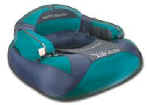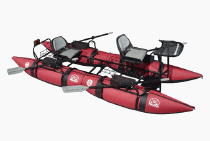Personal Watercraft
by Joe Panfalone
At club meetings, on the river, and around the tying bench, I often hear the same question, "What's the best boat for fly fishing?" Fortunately for the fly fisherman there are many choices that can be tailored to fit most any need. Unfortunately, the choices are so many you may have difficulty choosing just one. Like everything else in fly-fishing, you probably will end up with more than one to meet varying conditions.
I have my personal preference, but rather than share that with you and influence your decision, I will present a summary of my investigation which lead to my decision. Hopefully you will build upon it to search out what is right for you.
We will review personal watercraft in four categories:
(1) Float Tubes (2) Pontoon Boats (3) Kayaks (4) Canoes.
The industry is continually designing and redesigning to meet the discriminate demands of the fly fisher, so you will find some "hybrids" between categories.
Float Tubes
Float tubes and small ponds were made for each other. Suspended just above the water, propelled by fins, the angler can make a stealth approach towards the shoreline, weed beds, and other structure. The experience is serene and quite relaxing. That is, until you hook into that big one and your adrenalin kicks into high gear. The stories of how "the big one" pulled you in your tube around the pond have a propensity to get more grandiose with each narration.
We've progressed from the simple truck inner tube to much safer and more functional watercraft. Spacious cargo pockets provide storage for all your gear, there's even room to tuck in a sandwich or two. You should look for tubes that have rod holders and stripping aprons for line control. Most tubes are constructed with nylon outer shells and PVC bladders. The better tubes have multiple bladders for additional safety.
When float tubes first became available commercially, they were a bit pricy. Today you can buy a basic design for around $70. That's not a whole lot more that a quality fly line.
The advantage of a float tube is its portability. Deflated they can be carried in a duffle bag or in a back pack. Inflated, most weigh in at less than 10 pounds so they can easily be carried strapped to your back while hiking to remote areas. You might want to consider models that have back packing straps.
Floats tubes come in three styles:
- "O" shape (Belly Boat)
- "U" shape (U-Boat)
- "V" shape (Kick Boat)
**None of these are recommended for moving water.**
The Belly Boat
This is the traditional inner tube design in which the fisherman is totally surrounded by the tube. While some feel more secure in this style, exiting the water can be arduous and quite humorous to by-standers. The fisherman is at a disadvantage from several respects. Attempting to climb out of the water with with fins attached to your feet is something better accomplished by amphibious creatures than by homo sapiens. Also the ungainly inner tube around one's waist severely challenges one's sense of balance and coordination departing from the water's edge.
The U- Boat
An improvement to the belly boat is the u-boat. This is an open front design which makes entry and exiting a bit more graceful.
A safety bar across the front helps contain you within your seat as well as keeping the side bladders from separating under load.
The most common complaint is a sense of imbalance. Depending on how the design of the tube distributes your weight, the watercraft will lean forward giving a sense of falling out. Because there is an open space in front, there is no bladder to offer buoyancy when you reach out to land your fish. It is more of a matter of getting used to the characteristics of your watercraft rather than a safety factor.
V-Tube (Kick Boat)
"V" tubes, commonly referred to as kick boats incorporate an open front design with a elevated seat and a V hull which helps it move through the water easier. Seated above the water makes casting a little easier and you stay warmer in colder water. The downside is that you are more susceptible to wind making it more difficult to hold position. A little practice with your fins and it should not be a major problem. The belly boat and the U-boat do offer better back support.
Pontoon Boats
Pontoon boats were developed to meet the needs of anglers on moving waters. Introduced in the 1980's they have evolved into highly rockered inflatable pontoons straddled with sturdy frames to carry the load.
Weighing in around 60-100 pounds, steel frames being the heavier, they are less portable than float tubes. Never-the-less they can be managed by one person. I've modified a back pack frame to to carry mine unassembled. Oops! I let the cat out of the bag and told you my preference.
A premium feature is the molded swivel bucket seat which provides a comfortable posture with less fatigue. Pontoon construction is of the same heavy duty material used in white water rafts. Propulsion is by oars or by fins. Some models even have motor mounts.
These boats are excellent for both ponds, lakes, and moving rivers. They are exceptionally easy to get in and out of. When floating a stream and you come to a portage, simply stand up and let the boat float through while you wade. I use a retractable dog leash as tether.
The downside to personal watercrafts is that they are single person units. Your fishing buddy has to have one also. You can purchase a two man outfit which is essentially two single units joined together. You can fish them joined or as two single units. The nice thing about fishing them joined is that one person can maneuver the boat while the other fishes. There is a casting platform in front that enables the one fishing to stand keeping the line high above the water and the ears of his navigator.
Kayaks
Kayaks have been around for centuries.
Sleek lines and a long waterline length give them exceptional ability to navigate open water and whitewater conditions. Hull design is a compromise between stability and performance. For the sportsman a relatively flat wide bottom design commonly referred to as recreational kayaks are recommended.
The downside to kayaks is that your gear is not easily accessible and
some may find them claustrophobic. An alternative is a sit-on-top design. The deck is molded with a depression for the paddlers to sit into. With an open cockpit the gear is easier to get to.
A third type pf kayak is the inflatable which is about as stable a kayak as you can get. They are cross between
a kayak and a pontoon boat. Two tubular pontoons are joined in a "V" configuration both fore and aft. They are available in self bailing and hard type floors. With the installation of a set of oar locks and a opening in the floor, you can propel this craft either by fins or by oars.
For the less agile or older angler though, maintaining one's balance getting in and out of a kayak is challenging. Also plan on getting wet. Even though you may not draw water, when you get in and out, your shoes, especially felt soled, will drag in enough water to wet your bottom.
Canoes
While canoes have been used by the sportsman for years, and the silhouette of a fishermen in the North Woods makes for a dreamy picture, one thing is certain. Eventually you are going dump. The early versions did not have seats. You paddled while kneeling keeping your center of gravity low. To accommodate creature comfort, seats have been added modern canoes thus moving the center of gravity higher creating more potential for dumping.
Canoes are noisy, especially the aluminum ones. The large surface area in contact with the water creates a highly efficient sounding board that magnifies the slightest of sound. It is recommended that you line the floor with outdoor carpeting to act as a sound deadener.
There are numerous specification for canoes. One design crtiteria the fisherman should pay particular attention to is the design of the bottom.
- Flat bottom canoes are preferred by the sportsmen because they feel very secure on calm water. Flat bottom canoes, while they offer great initial stability, have less secondary stability; a feature not so well suited for river navigation.
- Shallow arch bottom canoes have less initial stability but good secondary stability. As the canoe is leaned, it will balance on its side and resist further tipping. Shallow arch canoes work well in waves and whitewater. Shallow arch bottom canoes offer the best all-around performance.
- Round bottom canoes have great secondary stability but very little initial stability. They are designed for speed and efficiency.
Copyright © 1998 - thisyear The Buckeye United Fly Fishers, Inc. Cincinnati, OH 45242
The Buckeye United Fly Fishers, Inc is a non-profit corporation organized under section 501(c)(3) of the Internal Revenue Code, incorporated in the State of Ohio for the preservation, conservation and wise use of our fishing waters and game fish; and to assist in the protection and improvement of our natural resources

